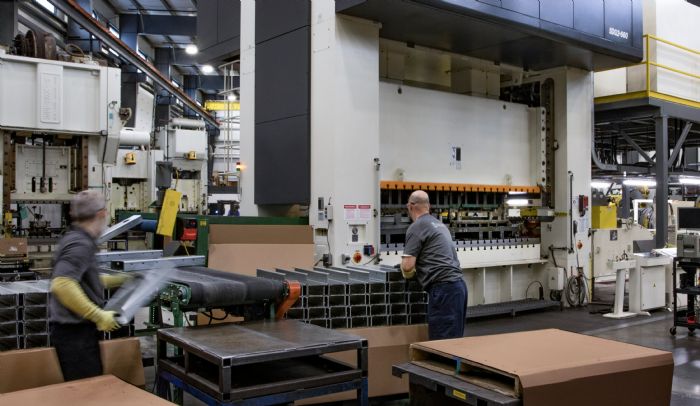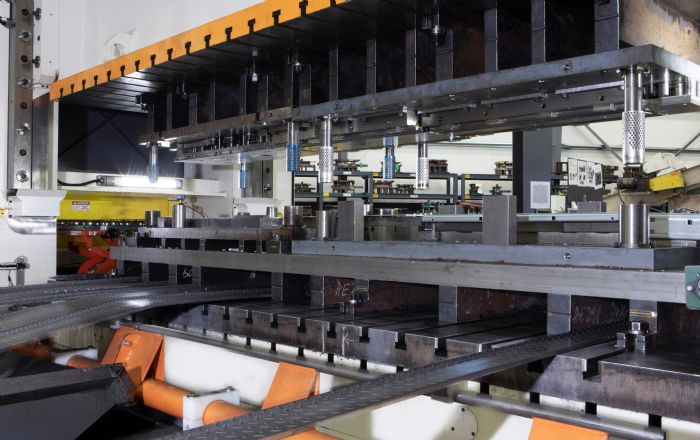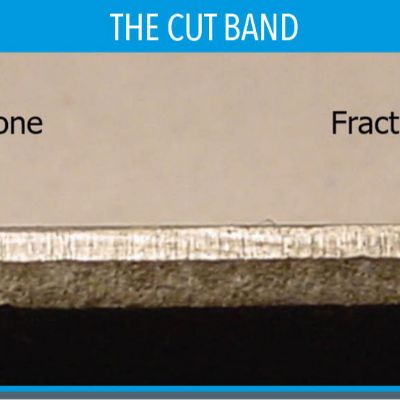Contributing here is the addition of the Coe WorkRoll Advisor tool, which automatically calculates the required straightener-roll depth based on workpiece-material type, thickness, width and yield strength—parameters entered into the line-control HMI by the operator. Then, the settings can be saved into the straightener’s job-recipe manager for quick recall the next time that material runs. Then, during production, Coe’s Work Roll Compensation feature monitors the coil OD and automatically adjusts the straightener to compensate for changes in coil set.
“In addition,” says Axelberg, “our tool-development team continues to learn how to take advantage of the different stroke profiles that we can program into the servo press. As an example, consider a high-volume bracket that we stamp for a solar customer, from 5⁄16-in. Grade 80 steel.
“The part has four slots stamped into it, measuring 0.709 by 2.48 in.,” Axelberg continues. “We machined a rooftop shear profile into the punches to keep the tonnage down, but stamping the parts on a conventional 800-ton mechanical press caused intermittent clearance burrs. When we moved the job to the servo press and developed a link-motion stroke profile, we completely eliminated the issue.”
A Key Contributor to Ongoing Growth
|
The centerpiece of the GSM pressroom is its new servomechanical press, a Seyi 660-ton model SDG2-660-S-5, outfitted with a 54-in. Coe feed line equipped with WorkRoll Advisor software. Industrial equipment supplier Press Automation Inc., Elkhart, IN, supplied GSM with the line. The devil is in the details: Press Specs Tonnage: 660 tons Stroke: 14.2 in. Die height: 34.25 in. Windows: 51 in. Slide adjustment: 10 in. Bed size: 145 by 61 in. Feed Line Includes dual threading table, and Coe 507 HD-series heavy-duty straightener Coil width capacity: 54 in. Max. feed length: 35 in. Sheet-thickness capacity: 0.62 in.; 3⁄8 in. at 24 in. wide Max Roll Speed: 319 ft./min. |
GSM has been on quite a run, with 2019 revenues up 42 percent over 2018, and the first quarter of 2020 up 53 percent over Q1 2019. “While the coronavirus has altered that trajectory significantly,” says Axelberg, “at least we know that we are well-positioned for survival, thanks in large part to the productivity and flexibility afforded by our new press.”
Among key measurables Axelberg and his team track, revenue per employee climbed from $245,000 in 2018 to $310,000 in 2019, he says, and revenue/ sq. ft. increased from $336 to $479.
“Revenue per square foot in the stamping department,” shares Axelberg, “more than doubled the company average in 2019, and we are confident that the superior productivity of the servo press will expand that margin in the years ahead.”
Axelberg is quick to share the credit for the company’s recent growth, starting with Ken Rose, director of operations, who joined GSM in June of 2018 after working for an aerospace-industry supplier. “Ken brought an understanding of the value of standard work and structured communication that we had been lacking up to that point,” Axelberg says. “His daily huddle with department supervisors prior to the shift hand-off, in addition to getting all of our leaders on the same page, provided a template that they now use with their own teams.
“It’s amazing how much easier growth is when everyone in the shop shares the same priorities at the same time,” Axelberg adds.
Yet another growth-enabling process, this one introduced by GSM director of engineering Jim Doolittle: a formal management of change (MOC) process, implemented at beginning of 2018. “Every capital project, new process or plant reconfiguration,” says Axelberg, “including the servo press acquisition, goes through a formal review that generates a detailed plan and related training materials. Jim added a process engineer to his team to help ensure that we have the resources needed to execute properly each new process. Our 2019 capex exceeded $9 million, and without a robust MOC process I am sure that we would have collapsed at some point.”
Finally, yet importantly, Axelberg credits the firm’s upgraded operator training and development program to helping to manage its rapid growth. “That program,” he says, “led by Kathy Crimmins, director of cultural development, now includes a formal curriculum, with objective assessments, for every operator-skill level in our core production departments. Not only does this enable employees to make bigger contributions more quickly than before, but it also correlates with a 30-percent reduction in turnover (at the South Bend plant as well as a second GSM facility in Tomah, WI) during 2019, without which we would have been unable to sustain the growth.” MF
View Glossary of Metalforming Terms
See also: Coe Press Equipment Corporation, SEYI America, Inc.
Technologies: Coil and Sheet Handling, Stamping Presses, Training








 Early in 2019, the management team at metal former and fabricator General Stamping & Metalworks (GSM) learned that demand for stamped parts in the fourth quarter would significantly exceed its existing press capacity. That growth spurt would come from one of the firm’s key customers in the utility-scale solar-power industry, as it expected a surge in orders related to the impending step-down of the federal solar tax credit.
Early in 2019, the management team at metal former and fabricator General Stamping & Metalworks (GSM) learned that demand for stamped parts in the fourth quarter would significantly exceed its existing press capacity. That growth spurt would come from one of the firm’s key customers in the utility-scale solar-power industry, as it expected a surge in orders related to the impending step-down of the federal solar tax credit. 


 Event
Event